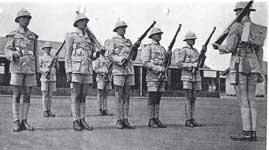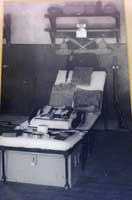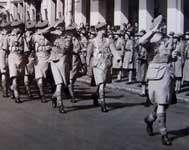Web Equipment, Braithwaite: Introduction
 The outcome of the Braithwaite Committee’s deliberations over 1932-4 was the selection of Mills’ “No. 3 Pattern” of web equipment. KW contributor Chris Forster has located a pair of short video clips showing a variation (not quite No. 3!) of the Braithwaite Committee Pattern web equipment and the accompanying experimental new uniform on the British Pathe Website. Whilst this received War Office approval, a decision to re-equip the British Army was not yet forthcoming. In the event, it never became the issue equipment. The photo at left, from the Rog Dennis Collection, shows South African troops on parade before the start of the war.
The outcome of the Braithwaite Committee’s deliberations over 1932-4 was the selection of Mills’ “No. 3 Pattern” of web equipment. KW contributor Chris Forster has located a pair of short video clips showing a variation (not quite No. 3!) of the Braithwaite Committee Pattern web equipment and the accompanying experimental new uniform on the British Pathe Website. Whilst this received War Office approval, a decision to re-equip the British Army was not yet forthcoming. In the event, it never became the issue equipment. The photo at left, from the Rog Dennis Collection, shows South African troops on parade before the start of the war.
 By 1935 the South African Defence Force had diminished to a very small Permanent Instructor Corps nucleus, which was backed up with numerous Active Citizen Force (A.C.F.) units, these corresponding to British Territorial Army units. South Africa adopted the new design as Braithwaite Web Equipment. No Pattern Year seems to have been allocated, though “Pattern 1935” has been used colloquially. Lethern comments that “…between 1934 and 1935 the Company manufactured several thousand sets…”. The examples here are all dated 1936, though, except for one item dated 1934, indicating production took place in at least one further year. Whether that indicates faulty memory (he was writing in 1956), or a subsequent production batch is not known. All components carry the Broad Arrow in “U” ownership mark of the Union Defence Force. The 1939 photo at right, also from the Rog Dennis Collection, shows Jan Smuts, newly elected P.M. of South Africa, reviewing the troops.
By 1935 the South African Defence Force had diminished to a very small Permanent Instructor Corps nucleus, which was backed up with numerous Active Citizen Force (A.C.F.) units, these corresponding to British Territorial Army units. South Africa adopted the new design as Braithwaite Web Equipment. No Pattern Year seems to have been allocated, though “Pattern 1935” has been used colloquially. Lethern comments that “…between 1934 and 1935 the Company manufactured several thousand sets…”. The examples here are all dated 1936, though, except for one item dated 1934, indicating production took place in at least one further year. Whether that indicates faulty memory (he was writing in 1956), or a subsequent production batch is not known. All components carry the Broad Arrow in “U” ownership mark of the Union Defence Force. The 1939 photo at right, also from the Rog Dennis Collection, shows Jan Smuts, newly elected P.M. of South Africa, reviewing the troops.

 The Braithwaite webbing in South Africa was issued to the Special Service Battalion (S.S.B.), a unit raised during the Depression to assist un-employed men. The unit was subjected to strict discipline (note the squared off Large packs!) and was soon seen as an elite unit. During the Second World War it became an armoured car regiment. Post-war, the S.S.B. was absorbed into the Regular Army and continues to serve today, now equipped with Rooikat (Lynx) armoured cars. The kit layout at left is a fine example of the chez moi variety, as opposed to an official photograph. This equipment belonged to Sergeant William Wallace, a member of the Special Service Battalion at the start of the war. It is reproduced here with the permission of his grandson, Will Endley. Note the Large and Small packs (latter seen end-on) on the shelf. We originally said "note the round Mess tins, which are distinctly different from the ones we show on the components page." Now, eagle-eyed John Lamont has spotted the distinctive curved handle of the South African style Mess tin on the lower shelf, just above the bed plate. This confirms that this type of Tin was used with W.E.B., but it raises another question. So, readers, what are the shiny round things on the foot of the bed?
The Braithwaite webbing in South Africa was issued to the Special Service Battalion (S.S.B.), a unit raised during the Depression to assist un-employed men. The unit was subjected to strict discipline (note the squared off Large packs!) and was soon seen as an elite unit. During the Second World War it became an armoured car regiment. Post-war, the S.S.B. was absorbed into the Regular Army and continues to serve today, now equipped with Rooikat (Lynx) armoured cars. The kit layout at left is a fine example of the chez moi variety, as opposed to an official photograph. This equipment belonged to Sergeant William Wallace, a member of the Special Service Battalion at the start of the war. It is reproduced here with the permission of his grandson, Will Endley. Note the Large and Small packs (latter seen end-on) on the shelf. We originally said "note the round Mess tins, which are distinctly different from the ones we show on the components page." Now, eagle-eyed John Lamont has spotted the distinctive curved handle of the South African style Mess tin on the lower shelf, just above the bed plate. This confirms that this type of Tin was used with W.E.B., but it raises another question. So, readers, what are the shiny round things on the foot of the bed?
Photographs show that the Pattern was still in service at the outbreak of the Second World War and an official kit list still shows the Pattern listed in 1945. On the rear of the photo at right, from the Karkee Web collection, is a pencilled inscription: "Here is David before he leaves for Egypt - June 17th 1940." Although it is not documented, the 4-strap gaiters and W.E., Braithwaite, certainly support a South African origin.
 John Lamont has just located the photo at left, reproduced here with the kind permission of Peter K.A. Digby, Curator, Transvaal Scottish Regimental Museum (Johannesburg). It shows a company of the TS returning from a village called Barberton in the Eastern Transvaal near the Mozambique and Swaziland borders, where a lot of field training was done. The troops are wearing Braithwaite Equipment, whilst the officers are wearing Patt. '08. This is significant, as it demonstrates that not just the SSB wore Braithwaite. The TS must have been re-equiped soon after this was taken, though, as the photos of John Lamont's father, who was in the Transvaal Scottish, show the men wearing Patt '37. The fact that the officers are in W.E., Patt. '08, also raises another interesting point: No. 3 W.E. had full provision for All Arms, so Brace attachments, Pistol cases, Binocular cases, Pistol cartridge pouches, etc., were all available from M.E. Co. If TS officers were using '08, it argues, as Rog Dennis has suggested in our write-up, that UDF did not take the full range of No. 3. Thus for pistols, they'd need either open leather .455-in. holster on 3-inch hooks, or its .38-in. web replacement, with 3-inch hooks. No weapons here, but '08 Brace attachments are in plain view.
John Lamont has just located the photo at left, reproduced here with the kind permission of Peter K.A. Digby, Curator, Transvaal Scottish Regimental Museum (Johannesburg). It shows a company of the TS returning from a village called Barberton in the Eastern Transvaal near the Mozambique and Swaziland borders, where a lot of field training was done. The troops are wearing Braithwaite Equipment, whilst the officers are wearing Patt. '08. This is significant, as it demonstrates that not just the SSB wore Braithwaite. The TS must have been re-equiped soon after this was taken, though, as the photos of John Lamont's father, who was in the Transvaal Scottish, show the men wearing Patt '37. The fact that the officers are in W.E., Patt. '08, also raises another interesting point: No. 3 W.E. had full provision for All Arms, so Brace attachments, Pistol cases, Binocular cases, Pistol cartridge pouches, etc., were all available from M.E. Co. If TS officers were using '08, it argues, as Rog Dennis has suggested in our write-up, that UDF did not take the full range of No. 3. Thus for pistols, they'd need either open leather .455-in. holster on 3-inch hooks, or its .38-in. web replacement, with 3-inch hooks. No weapons here, but '08 Brace attachments are in plain view.
South Africa’s decision to enter the War on the Allied side dictated that Patt. ’37 W.E. would be required to equip the hugely increased U.D.F., Mills having ceased production of No. 3. It is of interest that South Africa’s small Permanent Force meant they were able to take advantage of each of M.E.Co.’s webbing developments. In turn, they had adopted Patt. ’13 W.E. and Patt. ’25 and their Army now adopted the No. 3 Infantry Pattern.
Rog Dennis
January, 2010